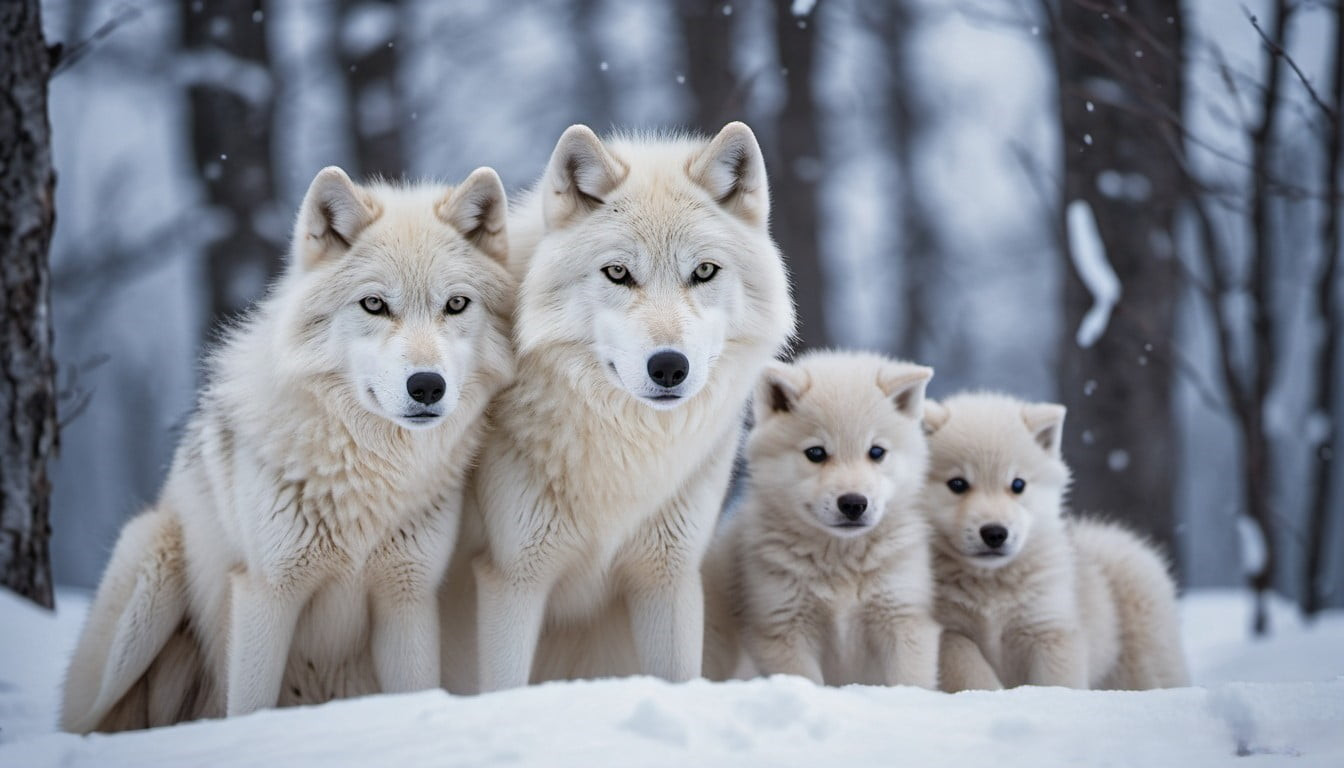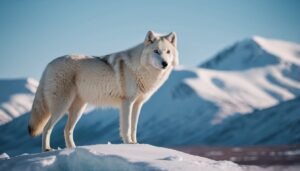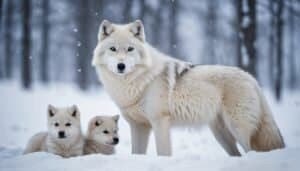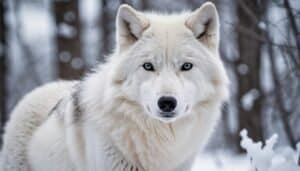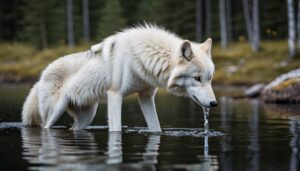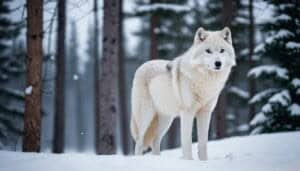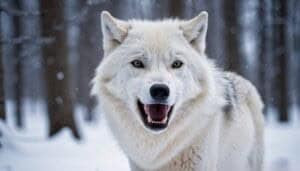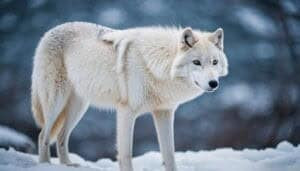Introduction
The Arctic wolf is a remarkable example of adaptation to extreme cold environments. This article delves into the unique adaptations of the Arctic wolf’s circulatory system that enable it to survive and thrive in such harsh conditions. We will explore how these adaptations compare to other canines, the role of countercurrent heat exchange, and specific changes in blood flow and fur interaction
Additionally, we will discuss the primary functions of the circulatory system in cold climates and examine the development of these adaptations from youth to maturity. Finally, we will review key research findings and future research directions in this fascinating field
Adaptations of the Arctic Wolf’s Circulatory System
The Arctic wolf’s circulatory system has evolved several unique adaptations that enable it to withstand the extreme cold of its environment. These adaptations are crucial for maintaining body heat, ensuring efficient blood flow, and protecting vital organs from the harsh temperatures. In this section, we will explore these specific adaptations and how they help the Arctic wolf survive in its frigid habitat
Comparison to Other Canines
Compared to other canines, the Arctic wolf’s circulatory system has distinct features that set it apart. While all canines have mechanisms to regulate body temperature, Arctic wolves have enhanced these mechanisms to cope with the severe cold
One notable difference is the increased blood flow to the extremities, which helps prevent frostbite. Unlike their temperate climate relatives, Arctic wolves have a more robust network of blood vessels near the skin surface, allowing for better heat distribution and retention
Role of Countercurrent Heat Exchange
One of the most critical adaptations in the Arctic wolf’s circulatory system is the countercurrent heat exchange mechanism. This system involves the close proximity of arteries and veins in the extremities, allowing warm blood flowing from the body core to transfer heat to the cooler blood returning from the limbs
This process minimizes heat loss and ensures that the extremities remain warm, even in sub-zero temperatures. The countercurrent heat exchange is particularly vital for the wolf’s paws, which are in constant contact with the icy ground
Paw Pad Adaptations
The paw pads of the Arctic wolf are another area where circulatory adaptations are evident. These pads have a dense network of blood vessels that provide warmth and prevent freezing. Additionally, the paw pads are covered in a thick, insulating layer of fur and fat, which helps maintain warmth
The combination of rich vascularization and insulation allows the Arctic wolf to move and hunt effectively on snow and ice without suffering from frostbite
Blood Flow Changes in Winter
During the winter months, the Arctic wolf’s circulatory system undergoes several physiological changes to enhance survival. Blood flow is directed away from the skin and extremities to conserve heat and protect core body temperature
However, the extremities still receive sufficient blood flow to prevent tissue damage. This dynamic regulation of blood flow ensures that the wolf remains warm and functional, even in the harshest winter conditions
Interaction of Fur and Circulatory System
The Arctic wolf’s thick fur coat works in tandem with its circulatory system to provide optimal thermal insulation. The fur traps a layer of air close to the skin, which acts as an additional insulator against the cold
Blood vessels near the skin surface can adjust their diameter to either conserve or release heat, depending on the environmental conditions. This interaction between the fur and circulatory system allows the Arctic wolf to maintain a stable body temperature and adapt to varying temperatures
These adaptations collectively enable the Arctic wolf to thrive in its icy environment. By understanding these mechanisms, we gain insight into the incredible resilience and ingenuity of nature in the face of extreme challenges
Primary Functions in Cold Climates
The primary functions of the Arctic wolf’s circulatory system in cold climates revolve around maintaining core body temperature, distributing nutrients, and ensuring efficient oxygen transport throughout the body
These functions are critical for the wolf’s survival, as they enable it to endure and thrive in extreme cold. This section will delve into how these vital processes are adapted to the harsh Arctic environment
Temperature Regulation
One of the foremost functions of the Arctic wolf’s circulatory system is temperature regulation. The circulatory system is meticulously designed to conserve heat and prevent hypothermia. The countercurrent heat exchange mechanism, previously discussed, plays a crucial role in this process by reducing heat loss from the extremities
Additionally, the dilation and constriction of blood vessels near the skin surface help manage heat retention and dissipation based on the external temperature. By adjusting blood flow, the Arctic wolf can maintain a stable internal temperature, which is essential for its metabolic processes
Nutrient Distribution
In the frigid Arctic environment, efficient nutrient distribution is vital for the Arctic wolf’s survival. The circulatory system ensures that nutrients absorbed from food are transported to cells and tissues throughout the body. During the winter, when food sources are scarce, this efficiency becomes even more critical
The circulatory system prioritizes nutrient delivery to vital organs, ensuring that the wolf remains energetic and capable of hunting. This prioritization is achieved through a dynamic allocation of blood flow, ensuring that essential organs receive the necessary nutrients while conserving energy in less critical areas
Oxygen Transport
Oxygen transport is another crucial function of the Arctic wolf’s circulatory system. Oxygen is necessary for cellular respiration, which produces the energy required for all bodily functions. The Arctic wolf’s circulatory system is optimized to deliver oxygen efficiently, even in the coldest conditions
Hemoglobin, the oxygen-carrying component of red blood cells, functions effectively at lower temperatures, ensuring that oxygen is adequately transported to tissues and organs. Additionally, the increased blood flow to extremities, facilitated by the dense network of blood vessels, ensures that all parts of the body receive sufficient oxygen, even in the cold
The synergy of these primary functions allows the Arctic wolf to maintain its energy levels, metabolic processes, and overall health, despite the challenges posed by its cold environment. Understanding these adaptations provides a comprehensive view of the intricate mechanisms that enable the Arctic wolf to endure and thrive in one of the harshest climates on Earth
Development and Research of Circulatory Adaptations
The development of the Arctic wolf’s circulatory adaptations begins early in life and continues as the wolf matures. These adaptations are crucial for survival in the Arctic environment and are a result of both genetic factors and environmental pressures
This section explores the developmental process of these adaptations in young Arctic wolves and reviews key research findings and future research directions
Adaptation in Young Arctic Wolves
Young Arctic wolves, like all mammals, are born with an immature circulatory system that gradually adapts to the harsh environment as they grow. Initially, the pups rely heavily on their mother’s warmth and milk to survive the cold. However, as they begin to explore and venture outside the den, their circulatory system undergoes significant changes
During this early stage, the development of a dense network of blood vessels in the extremities is critical. This network helps the young wolves maintain body heat and prevent frostbite. Additionally, the countercurrent heat exchange mechanism starts to become more efficient, allowing the pups to conserve heat more effectively
As the young wolves grow, their fur also thickens, working in tandem with the circulatory system to provide better insulation. The gradual improvement in blood flow regulation and heat retention capabilities prepares them for the challenges of Arctic life
Maturation Process
The maturation process of the Arctic wolf’s circulatory system involves further refinement of the adaptations developed in early life. As the wolves reach adulthood, their circulatory system becomes fully optimized for cold environments
This includes the enhancement of the countercurrent heat exchange mechanism, improved blood flow regulation, and the ability to adjust vascular resistance in response to temperature changes
Adult Arctic wolves also develop a more robust ability to direct blood flow to essential organs and tissues, ensuring efficient nutrient distribution and oxygen transport even in the coldest conditions. This maturity allows them to maintain high levels of activity, hunt effectively, and care for their young in the extreme Arctic climate
Key Research Findings
Research on the Arctic wolf’s circulatory system has revealed several fascinating insights into their adaptations. Studies have shown that the countercurrent heat exchange mechanism is one of the most efficient in the animal kingdom, allowing the wolves to conserve heat and maintain body temperature even in temperatures as low as -40°F (-40°C)
Another significant finding is the role of fur and subcutaneous fat in conjunction with the circulatory system. These layers provide an additional barrier against the cold, further enhancing the wolf’s ability to survive in its environment
Research has also highlighted the genetic basis of these adaptations, indicating that Arctic wolves have evolved specific traits that are passed down through generations
Future Research Directions
While significant progress has been made in understanding the Arctic wolf’s circulatory adaptations, there are still areas that require further investigation. Future research could focus on the molecular mechanisms underlying the development of the circulatory system and the genetic factors that contribute to these adaptations
Additionally, studying the impact of climate change on the Arctic wolf’s circulatory system is crucial. As temperatures rise and habitats change, understanding how these wolves will adapt to new environmental conditions will be vital for their conservation
Conclusion
The Arctic wolf’s circulatory system is a marvel of natural adaptation, enabling these animals to survive and thrive in one of the planet’s most extreme environments. Through detailed examination, we have uncovered how these wolves maintain their body heat, distribute nutrients, and transport oxygen efficiently in freezing conditions
From the intricate countercurrent heat exchange mechanism to the specific adaptations in their paw pads and fur interaction, the Arctic wolf’s circulatory system is a testament to evolutionary ingenuity
Starting from their early life, young Arctic wolves develop these critical adaptations that are refined as they mature, ensuring they are well-equipped to face the harsh Arctic climate. Research has provided significant insights into these mechanisms, highlighting the efficiency and effectiveness of the Arctic wolf’s circulatory system. Ongoing and future studies are essential to deepen our understanding, especially in the context of changing environmental conditions due to climate change
By exploring these fascinating adaptations, we gain a greater appreciation for the Arctic wolf’s resilience and the complex interplay between biology and environment that allows these magnificent creatures to endure the cold and harshness of the Arctic
